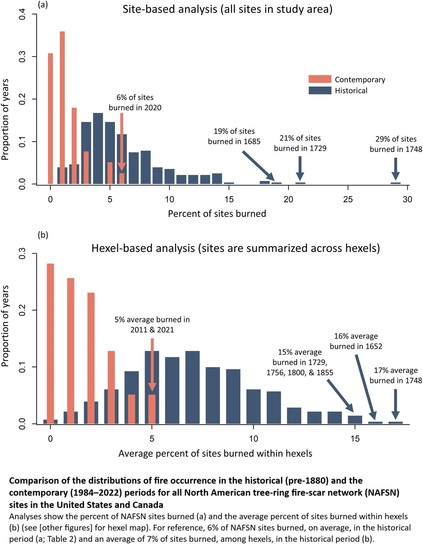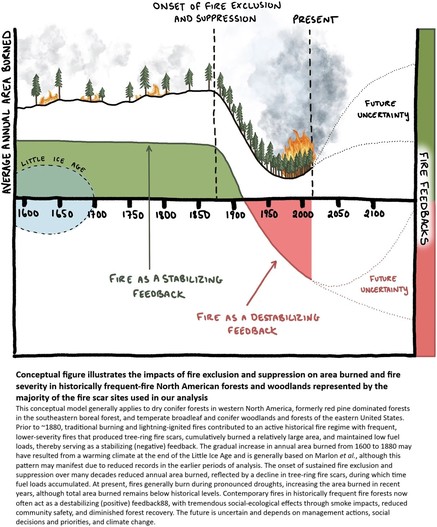A Fire Deficit Persists Across Diverse North American Forests Despite Recent Increases In Area Burned
--
https://doi.org/10.1038/s41467-025-56333-8 <-- shared paper
--
#GIS #spatial #mapping #spatialanalysis #spatiotemporal #fire #wildfire #bushfire #NorthAmerica #USA #Canada #management #planning #mitigation #climatechange #NAFSN #treering #firescar #forest #tree #vegetation #contemporary #model #severity #loss #cost #economics #ecosyastems #humanlife #infrastructure #risk #hazard #lossoflife #water #watersupply #waterresources
Recent searches
Search options
#treering
Cool study using #treering analysis to study precipitation variability over the past 4 centuries and aiding in the prediction of #extreme precipitation events and #droughts under future climate scenarios
https://www.sciencedirect.com/science/article/pii/S003101822500183X
New view on #treering analysis: Shining a new light on the classical concepts of carbon‐isotope dendrochronology https://nph.onlinelibrary.wiley.com/doi/10.1111/nph.20258
"Forests moderate local climate by keeping their local environments cool. They do this partly by shading the land, but also by releasing moisture from their leaves. This process, called transpiration, requires energy, which is extracted from the surrounding air, thus cooling it. A single tree can transpire hundreds of liters of water in a day. Each hundred liters has a cooling effect equivalent to two domestic air conditioners for a day, calculates Ellison."
https://e360.yale.edu/features/how-deforestation-affecting-global-water-cycles-climate-change
It's now part of my new #Tegtmeier project: figure out how much eg. European and American land use change has impacted local, regional and continental weather. See above posting where I asked this question, too.
So I plot #treering widths alongside d18O from #speleothem (eg. stalagmite). Both proxies are precisely dated and (can) have annual resolution.
I would expect to see a warming =
trees grow more when, at locations from where "their weather comes", other forests are felled .
And a drying =
d18O increase in speleothems.
I use #GoogleEarth and my rudimentary history knowledge to determine certain locations in Australia, New Zealand, USA and Europe. tbc.
#treering #18O #VPD #human #atmosphere #dry #forestry #agricultural #health #climatechange #drought
here is the link for full access: https://rdcu.be/duzAw
Recent human-induced atmospheric drying across Europe unprecedented in the last 400 years - combined #treering #18O analyses, Earth System model simulations and observations of the water vapour pressure deficit (#VPD) of the air show that this is due to #human influence. If the #atmosphere continues to #dry, impacts on natural ecosystem services, the #forestry and #agricultural sector and human #health are anticipated.
Tree Rings Reveal A New Kind Of Earthquake Threat To The Pacific Northwest
--
https://phys.org/news/2023-09-tree-reveal-kind-earthquake-threat.html <-- shared technical article
--
https://doi.org/10.1126/sciadv.adh4973 <-- shared paper
--
[as someone who has dove many, many times in the PNW, I am not sure I want that collection task ~wink~ ]
#GIS #spatial #mapping #PNW #earthquake #fault #faulting #paleoseismology #PacificNorthwest #treering #dating #relativedating #shallowfaults #model #modeling #naturalhazard #engineeringgeology #seismicevent #PugetSound #treeringdating #hazard #riskhazard #hazardmodel #regionalhazard #threat
The #medieval warm period was clearly colder then present #climate - results from #treering anatomy time series dating back 1170 years covering Fennoscandia: https://www.nature.com/articles/s41586-023-06176-4
Friend et al “Wood structure explained by complex spatial source-sink interactions” #TreeRing #WoodStructure https://www.nature.com/articles/s41467-022-35451-7
We have new paper out "Impacts of Climate and Tree Morphology on #TreeRing #Stable #Isotopes in Central Mongolia" lead by Caroline Leland of LDEO
https://academic.oup.com/treephys/advance-article/doi/10.1093/treephys/tpac142/6956957?utm_source=authortollfreelink&utm_campaign=treephys&utm_medium=email&guestAccessKey=dee526a1-75b4-4791-bad4-c74695852814





